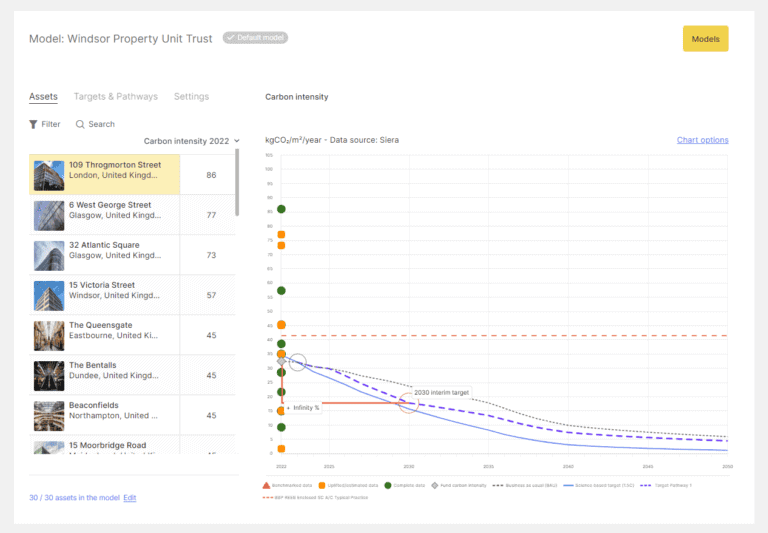
Thought
Race to Zero with SIERA: Decarbonisation Software for Sustainable Real Assets
EVORA’s Net Zero Carbon solution is purpose-built to power real asset decarbonisation. We ask Director Nick Hogg how SIERA’s groundbreaking module accurately predicts and optimises real asset pathways to net zero.
Hi Nick, what does net zero mean for real estate investors?
The urgency to reduce carbon emissions in real assets is paramount. The real estate sector contributes around 40% of global energy-related carbon emissions, with urban areas accounting for more than 60% of CO2 emissions. If we’re to meet crucial global climate goals, we must reduce carbon emissions by 45% by 2030 and achieve net zero by 2050.
Added to this colossal challenge, an estimated 85-95% of buildings standing today will still be in use in 2050. As highlighted by GRESB, this means uplevelling your existing assets and constructing new buildings to net-zero carbon standards. Failure to do so could result in stranded assets negatively impacting your investment portfolio.
For a number of operators it’s the upfront capital expenditure that can stand in the way of making improvements, but as a recent McKinsey & Company insight article finds: “Operators can create positive NPV-net-zero pathways by using analytics at the portfolio level to figure out the right order for implementation, which assets to invest in at what times, and how to link actions at the asset level with strategies for purchasing renewables.”
What steps can real estate investors and developers take to achieve net zero?
As a real estate investor or developer, you can make concerted efforts to accelerate your net zero carbon reductions and retrofit your low-performing assets. Monitoring carbon emissions, leveraging trusted reporting frameworks, and disclosing accurate carbon data builds business confidence in your increasingly sustainable portfolio. In doing so, you’re making a valued ethical contribution to global climate commitments.
How did SIERA’s add-on Net Zero Carbon solution come about?
In direct response to real estate market demand, the SIERA software team developed our Net Zero Carbon solution to meet this need. Many of our clients have made public commitments to meet decarbonisation targets by 2050 or even earlier. This means accessing data already held in one central secure location is key to tracking progress towards net zero targets.
We designed SIERA to make these net zero roadmaps easier to understand, manage, and accomplish at asset- and fund-level. The platform is built with global property, asset, fund, and sustainability stakeholders firmly in mind.
How can existing SIERA users benefit from the Net Zero Carbon solution?
The Net Zero Carbon solution provides two user options. The module can be used as a self-service software tool or in collaboration with our Net Zero consultancy services. This flexibility enables you to choose the method that best suits your needs and preferences.
Either way, its user-centric interface clearly highlights how to improve the availability and quality of your energy and carbon data. Its comprehensive automated gap-filling and occupancy normalisation helps users track the progress of their assets against net zero targets across large diverse and dynamically changing portfolios.
Talking of data, we understand that data can be overwhelming. That’s why the Net Zero Carbon solution does the heavy lifting for you. Clear visual dashboards outline multiple pathways to achieving net zero, whether it’s for individual assets or across an entire fund using SIERA Fund View.
SIERA reinforces these net zero pathways by automatically generating targets based on clear action plans. This unique capability ensures the impact of planned capex projects is rolled up to fund level, so you can make informed data-driven financial decisions that support your broader business objectives. The Net Zero Carbon solution guides you through your real asset transition to net zero and beyond.
Is the Net Zero Carbon solution ahead of its time or timely?
Both. This is the most advanced net zero software tool on the real asset sustainability market, so it’s way ahead of its time. And, from the perspective of today’s econopolitical climate, it’s perfect timing. Let me explain why.
The European Green Deal aims to achieve net zero by 2050 through several measures, including a more ambitious 2030 emissions reduction target and a carbon border adjustment mechanism. The European Climate Law legally binds the EU to the net zero target and establishes a process for regularly reviewing and increasing the EU’s climate targets.
Alongside the upcoming Net-Zero Industry Act, it’s expected that 40% of the necessary green tech to meet the EU’s climate and energy targets must be implemented by 2030. All these factors are, of course, being accelerated by the ongoing energy crisis in Europe, which is promoting a faster transition to clean energy in commercial real estate.
The UK has a legally binding target of achieving net zero greenhouse gas emissions (GHG) by 2050, setting five-yearly carbon budgets to limit emissions. The Government’s Ten Point Plan for a Green Industrial Revolution aims to achieve the 2050 target. This includes policies like investing in renewable energy and supporting low-carbon industries.
In the US, the Inflation Reduction Act is directing significant spending on climate priorities, tax credits for clean energy, and funding for clean tech. Backed by strong public support, this major climate policy aims to slash carbon emissions by 2030. It’s expected to hit industry and energy production hard. Businesses will shortly be asked to report on their carbon emissions for Scopes 1 and 2 (onsite and purchased electricity emissions) and eventually Scope 3 (supply chain and customer emissions).
Regardless of geography, it’s clear that the pressure to plug carbon data gaps, decarbonise assets, pursue sustainable investments, and achieve transparent net zero targets is on. The Net-Zero Asset Owner Alliance’s growing membership (more than 70 institutional asset owners representing $10+ trillion in assets and 7% of global investment) demonstrates this accelerated direction of travel towards decarbonised portfolios by 2050.
This undeniable econopolitical momentum is driving our SIERA Net Zero Carbon solution.
What are net zero pathways and how do they work in the Net Zero Carbon solution?
To implement an accurate net zero pathway, you need to compare your current carbon trajectory against best-practice routes supplied by the Science Based Target initiative (SBTi) Corporate Net-Zero Standard. The SBTi is the first global framework to set out corporate net zero targets in line with climate science.
The SBTi has joined forces with CRREM to provide fully aligned 1.5°C decarbonisation pathways for real estate. In simple terms, the SBTi sets targets for reducing emissions and CRREM assesses the risk and maps out paths to zero carbon. This partnership enables CRREM users to access SBTi’s target-setting methods, and SBTi users to use CRREM’s tool for risk assessment and path mapping. It’s a win-win.
However, you need to input your ESG data into the CRREM tool. This can be tedious and time-consuming. So, the SIERA Net Zero Carbon solution steps in to help.
First, SIERA constantly accesses, updates, and applies all available energy data onboarded for your assets. Effective data coverage also saves you time because you no longer need to export data offline. As a preferred CRREM service provider, SIERA leverages the CRREM data model to auto-populate its industry benchmark data, according to the building characteristics, energy usage, and renewables information of your asset types.
Second, SIERA combines this energy data to predict two decarbonisation routes:
- Business As Usual (BAU) pathway: your expected roadmap without carbon reduction (where you are)
- Science-Based Target (SBT) pathway: your optimal roadmap to reach net zero (where you need to be)
The Net Zero Carbon solution helps you close the gap between these two pathways, so you achieve net zero by 2050, or sooner.
How do businesses close the gap between their BAU and SBT pathways?
There are two approaches. From ‘the top’ or from ‘the ground up’, depending on your preferred net zero strategy.
In the first approach, SIERA creates Target-Based Carbon Pathways built on your imported asset-level data and CRREM/SBTi benchmark data, which I talked about earlier.
As a user, you simply add your intended carbon reductions (%) for every year, specific years, or milestones to risk-model up to three different scenario pathways at your chosen asset/s. SIERA then predicts your current BAU pathway (which takes account the impact of grid decarbonisation in different markets), your ideal SBT pathway, and your optimised Target-Based Carbon pathway. These three pathways are visualised on a graph for quick comparison. Ideally, your Target-Based Carbon pathway should sit beneath your SBT pathway to ensure you accomplish net zero on time and in budget.
Anything above must be offset further down the line. Verra, the credibility guarantor of the $2bn voluntary offsets market, has announced a commitment to phase out its rainforest offsets programme by 2025 and implement more transparent regulations. Whatever the outcome, optimising your carbon reduction from the outset is the best course of action.
In the second approach, SIERA creates Action-Based Carbon pathways. These pathways are also built on your imported asset-level data and your matched CRREM/SBTi benchmark data.
However, here’s the difference. SIERA helps you model the impact of planned actions based on the estimated savings and timescales for implementation. For example, scenario one could implement retrofitting actions like LED installation and HVAC systems, whereas scenario two could involve fitting roof solar panels, and scenario three could factor in renewable energy sources.
Each scenario produces a distinct visual Action-Based Carbon Pathway. These pathways account for the cost of each scenario and the carbon-reduction benefits to help you evaluate the most suitable risk model for your net zero strategy and enable you use capex more effectively. Once set, your chosen pathway is tracked for routine adjustments to reflect changing energy, environmental, and regulatory factors.
Nick, so ‘what gets measured, gets managed’? Does data sit at the heart of achieving net zero?
In an ideal word, accurate net zero pathways – action based and/or target based – are dependent on investment-grade data. Collecting consistent high-quality energy consumption data across all your assets will provide more accurate carbon data for more strategic decarbonisation pathways.
However, we understand that collecting a complete set of energy data presents a huge challenge in the real estate sector. Unless your energy and water consumption data collection is fully automated, error-free, and 100% complete, you’re reliant on estimated or industry benchmark data to some extent. That’s why it’s so important to evaluate the quality of your existing ESG data. Again, SIERA steps in to help.
Behind the scenes, the Net Zero Carbon tool whirls into action to rank the quality of your available energy consumption data and determine your carbon emissions. Each asset is ranked for its Data Availability and resultant Data Quality. Likewise, an overview of your fund’s status is shown on an Aggregated Data Quality card. And these results are all displayed on your Asset View dashboard.
- 100% complete real data projects accurate net zero pathways
- 51-99% data bolstered by estimated data (based on your previous six-month data collection) predicts highly reliable net zero pathways
- < 50% data replaced by more consistent CRREM benchmark data predicts industry-standard net zero pathways
So, even when data is unavoidably absent, SIERA still enables you to plot comprehensive scenario pathways to guide your net zero decision-making. For example, it pinpoints your missing energy consumption data to reveal your most ‘problematic assets’. Improving the data collection and quality of those biggest ‘offenders’ will reap the greatest reward for your net zero strategy. When you understand your data, you can manage your net zero risk. This results in more sustainable strategies to protect your bottom line.
What is carbon intensity and why does it matter?
Carbon intensity and energy intensity are important measures of efficiency and environmental impact. Energy intensity measures how efficiently energy is consumed per unit area, regardless of its renewable nature. Carbon intensity, on the other hand, assesses the level of GHGs based on the source of energy. These measures help us understand and improve our energy usage for a greener and more sustainable future. Assets with a low carbon intensity indicate good performance or lower risk.
In the Net Zero Carbon solution, you can select all your assets on a descending scale from most carbon intensive to least carbon intensive to help you identify outliers and prioritise actions for improvement. You can also rank assets by their value to weigh up the cost-effectiveness of implementing recommended target-based carbon reductions for each asset.
Likewise, you can use this insight to evaluate the cost of retrofitting specific buildings against the potential investment benefits for your portfolio. You might decide to sell your most carbon-intensive assets. It all depends on the compilation of your portfolio and your net zero strategy.
For an even deeper analysis, you can review the carbon intensity data for each asset. Alternatively, your aggregated asset performance card displays the average carbon intensity, cost intensity, energy intensity, and carbon emissions for a bird’s-eye view of your entire fund.
Can you illustrate how carbon intensity works using a use case example?
In this visual example, the Windsor Property fund contains 30 assets displayed in descending order for carbon intensity. The Throgmorton asset shows high carbon intensity, so this immediately captures our attention. This asset’s available energy consumption data is also 100% complete, so we know the predicted net zero pathways are accurate. Of concern, there’s a wide gap between the BAU and SBT pathways. This needs to be reduced to achieve net zero through Target-Based Carbon Pathways or Action-Based Carbon Pathways.

Depending on your net zero strategy, the Throgmorton asset could also threaten your net zero carbon commitments. Two choices… Offload at a potential loss, but save on carbon reduction costs? Retain, but pay out for a costly retrofit. If Throgmorton resides in a desirable location or boasts a unique set of features, its long-term investment value may well make it a worthy candidate for retention. Whatever the carbon status of your assets and your investment strategy, these data visualisations support more insightful decision-making for improved financial outcomes.
Summing up, how does the Net Zero Carbon solution benefit real asset owners and investors?
Ambitious net zero goals add credibility to your business if you deliver on your pledges. That’s why you need to track your carbon emissions and measure the net zero carbon performance of your assets. Visualisations chart your data on an ongoing basis to periodically illustrate whether your carbon is above or below your set targets for each asset. SIERA’s Net Zero Carbon solution paves the most direct roadmap for resilient assets across seven key steps:
1. Model, visualise, and control net zero target pathways
2. Make time-sensitive net zero decisions ahead of scheduled commitments (2030, 2040, 2050)
3. Invest in the right assets in the right place at the right time
4. Avoid or offload stranded assets to secure short-term ROI
5. Future-proof valuable assets for net zero to secure long-term ROI
6. Comply with net zero national and regional legislation and regulations
7. Protect and enhance your public reputation for transparent net zero reporting













